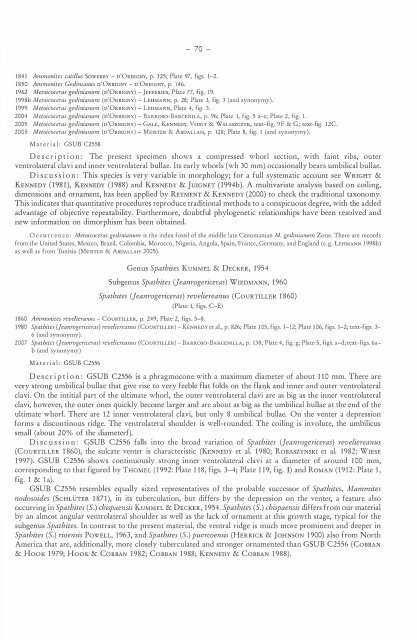Late Cretaceous ammonites from the Bou Angueur syncline (Middle ...
Late Cretaceous ammonites from the Bou Angueur syncline (Middle ...
Late Cretaceous ammonites from the Bou Angueur syncline (Middle ...
Create successful ePaper yourself
Turn your PDF publications into a flip-book with our unique Google optimized e-Paper software.
- 70 -<br />
1841 Ammonites catillus SowERBY - n'ORBIGNY, p. 325; Plate 97, figs. 1-2.<br />
1850 Ammonites Geslinianus n'ORBIGNY - n'ORBIGNY, p. 146.<br />
1962 Metoicoceras geslinianum (n'ORBIGNY) - }EFFERIES, Plate 77, fig. 19.<br />
1998b Metoicoceras geslinianum (n'ORBIGNY) - LEHMANN, p. 28; Plate 3, fig. 3 (and synonymy).<br />
1999 Metoicoceras geslinianum (n'ORBIGNY) - LEHMANN, Plate 4, fig. 3.<br />
2004 Metoicoceras geslinianum (n'ORBIGNY) - BARROSO-BARCENILA, p. 96; Plate 1, fig. 5 a-c; Plate 2, fig. 1.<br />
2005 Metoicoceras geslinianum (n'ORBIGNY) - GALE, KENNEDY, VorGT & WALASZCZYK, text-fig. 9F & G; text-fig. 12C.<br />
2005 Metoicoceras geslinianum (n'ORBIGNY) - MEISTER & ABDALLAH, p. 128; Plate 8, fig. 1 (and synonymy).<br />
Material: GSUB C2558<br />
Description: The present specimen shows a compressed whorl section, with faint ribs, outer<br />
ventrolateral clavi and inner ventrolateral bullae. Its early whorls (wh 30 mm) occasionally bears umbilical bullae.<br />
Discussion: This species is very variable in morphology; for a full systematic account see WRIGHT &<br />
KENNEDY (1981), KENNEDY (1988) and KENNEDY & }UIGNET (1994b). A multivariate analysis based on coiling,<br />
dimensions and ornament, has been applied by REYMENT & KENNEDY (2000) to check <strong>the</strong> traditional taxonomy.<br />
This indicates that quantitative procedures reproduce traditional methods to a conspicuous degree, with <strong>the</strong> added<br />
advantage of objective repeatability. Fur<strong>the</strong>rmore, doubtful phylogenetic relationships have been resolved and<br />
new information on dimorphism has been obtained.<br />
0 cc u r re n c e: Metoicoceras geslinianum is <strong>the</strong> index fossil of <strong>the</strong> middle late Cenomanian M. geslinianum Zone. There are records<br />
<strong>from</strong> <strong>the</strong> United States, Mexico, Brazil, Colombia, Morocco, Nigeria, Angola, Spain, France, Germany, and England (e. g. LEHMANN 1998b)<br />
as well as <strong>from</strong> Tunisia (MEISTER & ABDALLAH 2005).<br />
Genus Spathites KuMMEL & DECKER, 1954<br />
Subgenus Spathites Ueanrogericeras) WIEDMANN, 1960<br />
Spathites Ueanrogericeras) reveliereanus (CouRTILLER 1860)<br />
(Plate 1, figs. C-E)<br />
1860 Ammonites revelieranus - CouRTILLER, p. 249; Plate 2, figs. 5-8.<br />
1980 Spathites Ueanrogericeras) reveliereanus (CouRTILLER) - KENNEDY et al., p. 826; Plate 105, figs. 1-12; Plate 106, figs. 1-2; text-figs. 3-<br />
6 (and synonymy).<br />
2007 Spathites Ueanrogericeras) reveliereanus (CouRTILLER) - BARROSO-BARCENILLA, p. 138; Plate 4, fig. g; Plate 5, figs. a-d; text-figs. 6ab<br />
(and synonymy)<br />
Material: GSUB C2556<br />
Description: GSUB C2556 is a phragmocone with a maximum diameter of about 110 mm. There are<br />
very strong umbilical bullae that give rise to very feeble flat folds on <strong>the</strong> flank and inner and outer ventrolateral<br />
clavi. On <strong>the</strong> intitial part of <strong>the</strong> ultimate whorl, <strong>the</strong> outer ventrolateral clavi are as big as <strong>the</strong> inner ventrolateral<br />
clavi, however, <strong>the</strong> outer ones quickly become larger and are about as big as <strong>the</strong> umbilical bullae at <strong>the</strong> end of <strong>the</strong><br />
ultimate whorl. There are 12 inner ventrolateral clavi, but only 8 umbilical bullae. On <strong>the</strong> venter a depression<br />
forms a discontinous ridge. The ventrolateral shoulder is well-rounded. The coiling is involute, <strong>the</strong> umbilicus<br />
small (about 20% of <strong>the</strong> diameterf).<br />
Discussion: GSUB C2556 falls into <strong>the</strong> broad variation of Spathites Ueanrogericeras) reveliereanus<br />
(CouRTILLER 1860), <strong>the</strong> sulcate venter is characteristic (KENNEDY et al. 1980; RoBASZYNSKI et al. 1982; WIESE<br />
1997). GSUB C2556 shows continuously strong inner ventrolateral clavi at a diameter of around 100 mm,<br />
corresponding to that figured by THOMEL (1992: Plate 118, figs. 3-4; Plate 119, fig. 1) and RoMAN (1912: Plate 1,<br />
fig. 1 & la).<br />
GSUB C2556 resembles equally sized representatives of <strong>the</strong> probable successor of Spathites, Mammites<br />
nodosoides (ScHLUTER 1871), in its tuberculation, but differs by <strong>the</strong> depression on <strong>the</strong> venter, a feature also<br />
occurring in Spathites (S.) chispaensis KuMMEL & DECKER , 1954. Spathites (S.) chispaensis differs <strong>from</strong> our material<br />
by an almost angular ventrolateral shoulder as well as <strong>the</strong> lack of ornament at this growth stage, typical for <strong>the</strong><br />
subgenus Spathites. In contrast to <strong>the</strong> present material, <strong>the</strong> ventral ridge is much more prominent and deeper in<br />
Spathites (S.) rioensis PowELL, 1963, and Spathites (S.) puercoensis (HERRICK & ]oHNSON 1900) also <strong>from</strong> North<br />
America that are, additionally, more closely tuberculated and stronger ornamented than GSUB C2556 (CoBBAN<br />
& HooK 1979; HooK & CoBBAN 1982; CoBBAN 1988; KENNEDY & CoBBAN 1988).

















